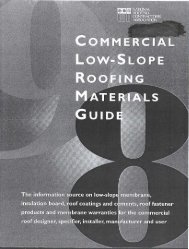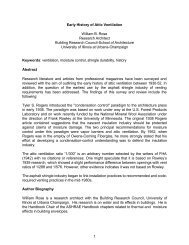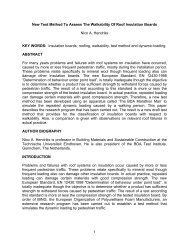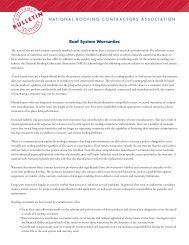Holy hail!
Holy hail!
Holy hail!
Create successful ePaper yourself
Turn your PDF publications into a flip-book with our unique Google optimized e-Paper software.
<strong>Holy</strong><br />
<strong>hail</strong>!<br />
Editor’s note: Following is the second in a<br />
two-part series addressing <strong>hail</strong> damage to<br />
roof systems. Part one appeared in the May<br />
issue, page 34, and focused on steep-slope<br />
roof systems.<br />
Following <strong>hail</strong>storms, roofing professionals,<br />
insurance professionals and building<br />
owners often automatically assume roof<br />
systems need to be repaired or replaced.<br />
However, though <strong>hail</strong> can inflict serious<br />
damage on roof systems, this is not always<br />
the case.<br />
To identify <strong>hail</strong> damage on low-slope<br />
roof systems, you must understand basic<br />
properties of various low-slope roof system<br />
types and be able to recognize the effects<br />
of other natural perils, inherent manufacturing<br />
issues and typical weathering issues.<br />
As I mentioned in part one, a roof system<br />
is not considered functionally damaged<br />
by <strong>hail</strong> unless the roof’s weather<br />
resistance capabilities are diminished or<br />
the roof’s expected service life is reduced.<br />
And whether a roof system is functionally<br />
damaged by <strong>hail</strong> depends on the <strong>hail</strong> size<br />
and hardness and roof system type and<br />
condition.<br />
General rules<br />
There are some general rules to consider<br />
when investigating a <strong>hail</strong>-damaged lowslope<br />
roof system.<br />
First, the thicker the membrane, the<br />
greater the <strong>hail</strong> resistance. For bituminous<br />
and thermoplastic roof membranes,<br />
the more weathered the roofing material,<br />
the more brittle the membrane and, therefore,<br />
the less impact resistance it will have.<br />
The stiffer the underlying substrate, the<br />
more <strong>hail</strong>-resistant the roof membrane.<br />
Gravel surfacing affords substantial <strong>hail</strong><br />
protection—more and larger aggregate surfacing<br />
typically means greater resistance.<br />
Fractures caused by <strong>hail</strong>stone impacts<br />
typically start in membranes’ undersides<br />
where tensile strains are greatest and propagate<br />
toward membranes’ topsides. Base<br />
flashing usually is damaged by <strong>hail</strong> before<br />
other parts of a low-slope roof system because<br />
of its exposure and typically less<br />
solid underlying support.<br />
When looking for <strong>hail</strong> damage on lowslope<br />
roof systems, remember:<br />
• Over time, fracture edges become progressively<br />
more rounded and fracture<br />
surfaces more weathered; <strong>hail</strong>-caused<br />
damage does not disappear.<br />
• The cutting and removing of samples<br />
from a roof membrane permits an inspector<br />
to examine the roof covering’s<br />
underside where impact-caused fractures<br />
initiate. (Such destructive testing<br />
may not always be possible.)<br />
• Roofing samples can be transported<br />
to a laboratory and further examined<br />
under magnification. Bitumen can<br />
be desaturated from roofing and reinforcements<br />
extracted; thermoplastic<br />
membranes can be backlit by high-<br />
38 June 2009 www.professionalroofing.net
Identifying <strong>hail</strong> damage on roof systems<br />
by Scott J. Morrison, P.E.<br />
intensity light and scrutinized visually;<br />
roofing materials can be X-rayed (in<br />
instances where protective surfacing is<br />
other than granules or gravel ballast)<br />
and fractures detected; and magnetic<br />
resonance imaging can be performed<br />
to determine the position of fractures<br />
within the material’s thickness.<br />
• Impacts can be made against roof<br />
assemblies with simulated <strong>hail</strong>stones<br />
and compared with areas of interest<br />
on roof systems.<br />
• Infrared thermography and impedance<br />
meters can help identify whether water<br />
has migrated through <strong>hail</strong>-caused openings<br />
and into roof assemblies.<br />
Damage thresholds<br />
Hail must be a certain size and hardness to<br />
functionally damage low-slope roof systems.<br />
However, the size required varies depending<br />
on low-slope roof system type and<br />
condition.<br />
The figure lists the smallest size thresholds<br />
for common low-slope roof system<br />
types. The thresholds, which are the culmination<br />
of more than 45 years of laboratory<br />
testing with simulated <strong>hail</strong> and tens<br />
of thousands of field inspections, are provided<br />
given the following set of assumptions:<br />
hard <strong>hail</strong>, perpendicular impacts,<br />
average support, and roof systems in relatively<br />
good or midlife condition.<br />
Built-up<br />
A built-up roof (BUR) system is composed<br />
of a series of reinforcements bonded together<br />
with a waterproofing material such<br />
as asphalt, coal tar or polymer-modified<br />
bitumen. Hail of sufficient size, speed and<br />
hardness can puncture, tear or bruise a<br />
BUR membrane.<br />
Hail-caused fractures always are visible<br />
on a membrane’s underside (unless obscured<br />
by insulation remnants or adhesives).<br />
Although some fractures may not<br />
be obvious in roof surfaces, they can be<br />
detected by hand and feel like localized<br />
soft spots or bruises on an apple. The softness<br />
results from broken reinforcements in<br />
the membrane.<br />
When a BUR system is smooth-surfaced<br />
(surface flooded with bitumen or coated<br />
with aluminum, polymer or emulsion),<br />
impact marks and resulting punctures and<br />
fractures are detectable when examined<br />
closely and tactilely. If a BUR system is<br />
aggregate-surfaced, you must first sweep (or<br />
blow) the loose surfacing aside. This will<br />
expose any nonweathered, black-colored<br />
bitumen where sizeable <strong>hail</strong> has dislodged<br />
and ejected the flood coat with surfacing<br />
from the impacted site.<br />
A BUR system’s expected service life<br />
can be shortened when protective surfacing<br />
is dislodged by <strong>hail</strong>. Examples include<br />
the flood coat bitumen or gravel embedded<br />
in the flood coat broken away or aluminum,<br />
polymer or emulsion coatings<br />
disrupted.<br />
ProfessionalRoofing June 2009 39
A <strong>hail</strong>-caused bruise in a built-up roof membrane with an aluminum coating<br />
Gravel is not driven into the membrane but ejected from the impact<br />
location.<br />
Polymer-modified bitumen<br />
Polymer-modified bitumen membranes are<br />
composed of fiberglass and/or polyester<br />
reinforcement, and their top surfaces are<br />
protected by surfacing such as factoryembedded<br />
granules, factory-bonded foils<br />
or field-applied coatings.<br />
Hailstones of sufficient size and hardness<br />
can puncture, tear or bruise a polymermodified<br />
bitumen membrane where they<br />
strike and reduce the membrane’s weatherproofing<br />
capability. A roof system’s expected<br />
service life can be reduced when <strong>hail</strong> disrupts<br />
the membrane’s protective surfacing<br />
and exposes its coating bitumen.<br />
The best way to examine a polymermodified<br />
bitumen membrane is to feel<br />
areas with sizeable impact marks by pushing<br />
against the membrane to discern localized<br />
soft spots, which indicate ruptures in<br />
the reinforcement. Fractures in polymermodified<br />
bitumen membranes’ top surfaces<br />
can be curvilinear or a series of fractures<br />
in a concentric pattern. Fractures in<br />
concentric patterns in membrane surfaces<br />
typically are accompanied by fractures in<br />
star-shaped patterns (multiple fractures<br />
radiating from common impact points)<br />
in membranes’ undersides.<br />
Areas without <strong>hail</strong>-caused punctures, tears<br />
or bruises where granules have been dislodged<br />
must be probed further to determine<br />
whether the exposed polymer-modified<br />
bitumen has additional underlying granules.<br />
In many instances, though some<br />
granules will have been dislodged and<br />
dark-colored bitumen exposed at the impact<br />
site, you will discover additional<br />
granules just below the exposed bitumen’s<br />
surface. These granules protect the polymermodified<br />
bitumen and reinforcement below;<br />
therefore, there is no loss of service life and<br />
no functional damage.<br />
Single-ply membranes<br />
To learn more about <strong>hail</strong>, log on to www.professionalroofing.net.<br />
Common thermoplastic membranes such<br />
as PVC and TPO typically incorporate<br />
reinforcement in woven forms known as<br />
scrims. The most prevalent thermoset roof<br />
membrane is EPDM, which is produced<br />
as reinforced (with polyester scrims) and<br />
nonreinforced membranes. Hail damage<br />
to thermoplastic membranes includes<br />
fractures or tears in the material body<br />
or reinforcement.<br />
Roof areas most sensitive to damage<br />
typically are at underlying stress plates in<br />
lap seams of mechanically attached systems<br />
or those used for fastening underlying<br />
insulation boards.<br />
Hailstone strikes against membranes at<br />
stress plate edges are known as “anvil strikes”<br />
and result in crescent-shaped fractures 1 ⁄16 of<br />
an inch to 1 inch long. Fractures in thermoplastic<br />
membranes (away from stress plates)<br />
over insulation or deck materials can be<br />
curvilinear, star-shaped or a series of fractures<br />
in a concentric pattern.<br />
Larger fractures in thermoplastic membranes<br />
are plainly visible. Smaller fractures<br />
require closer inspection and hand manipulation<br />
to identify. Pushing on a membrane<br />
will identify dents in underlying insulation<br />
for further scrutiny. Tugging at the membrane<br />
at areas in question will open miniscule<br />
fractures.<br />
When looking for <strong>hail</strong>-caused damage<br />
in thermoplastic roof membranes, keep in<br />
mind:<br />
• Fractures in membranes generated by<br />
<strong>hail</strong>stone impacts are immediate and detectable<br />
by a knowledgeable inspector.<br />
• Hail-caused fractures are visible immediately<br />
in all membranes’ undersides.<br />
• Fractures caused by <strong>hail</strong> are visible<br />
immediately when backlit by highintensity<br />
light.<br />
• Good lighting is important for identifying<br />
smaller fractures in thermoplastic<br />
membranes.<br />
• Water, snow and ice on a membrane<br />
may obscure fractures completely.<br />
• Fractures in some thermoplastics,<br />
especially PVC, may not be readily<br />
40 June 2009 www.professionalroofing.net
Photos courtesy of Haag Engineering Co., Irving, Texas<br />
A star-shaped fracture in a brittle nonreinforced PVC membrane (with<br />
shrinkage)<br />
Fractures in coating and spray polyurethane foam crushed by a <strong>hail</strong>stone<br />
visible in membranes’ top surfaces<br />
until the membrane has “relaxed.”<br />
• Fractures in brittle nonreinforced PVC<br />
membranes are star-shaped and tend<br />
to propagate when the membrane is<br />
taut.<br />
• EPDM is an elastic material and does<br />
not accumulate stress or fatigue when<br />
struck by multiple <strong>hail</strong>stones.<br />
• Generally, thermoplastic roof membranes<br />
are more sensitive to impactcaused<br />
damage in colder temperatures.<br />
• Insulation below membranes can be<br />
dented or fractured, which may constitute<br />
functional damage.<br />
SPF<br />
Spray polyurethane foam (SPF) roof systems<br />
are composed of multiple lifts of<br />
polyurethane foam finished with an<br />
elastomeric coating. Depending on <strong>hail</strong>’s<br />
attributes, resulting damage can range from<br />
fractures in the elastomeric coating to punctures<br />
in coating accompanied by crushing<br />
or fracturing of the polyurethane foam.<br />
Closely inspect SPF roof systems for<br />
<strong>hail</strong>-caused damage, and feel any areas of<br />
concern by hand. Recommendations for<br />
repairs are available from the Spray Polyurethane<br />
Foam Alliance based on the extent<br />
and frequency of the damage.<br />
Metal<br />
Inspectors will encounter many types of<br />
metal roofing materials. Metal can weather<br />
naturally or be protected by coatings. Panels<br />
are manufactured in a variety of widths<br />
and thicknesses with various types of seam<br />
configurations and applied with exposed<br />
or concealed fasteners.<br />
Hail thresholds for low-slope roof coverings<br />
Roof type<br />
Threshold (inches)<br />
Built-up roofing—smooth 1 3 ⁄4 to 2<br />
Built-up roofing—aggregate-surfaced 2 1 ⁄2<br />
Polymer-modified bitumen membranes 1 1 ⁄2 to 2<br />
Thermoplastic single-ply membranes 1 to 2<br />
EPDM 2<br />
EPDM—ballasted 2 1 ⁄2<br />
Spray polyurethane foam 3<br />
⁄4<br />
Steel panels 2 1 ⁄2<br />
The smallest threshold sizes of <strong>hail</strong> that can damage various low-slope roof coverings<br />
When investigating <strong>hail</strong> damage, closely<br />
examine metal roofing panels. These can<br />
be damaged when <strong>hail</strong>stone parameters are<br />
sufficient to rupture the metal, disengage<br />
lap elements or disrupt protective coatings.<br />
Ruptures in panels and disengaged lap elements<br />
are obvious.<br />
Micrographs have verified that thinning<br />
of metal—even within deep dents—is insignificant.<br />
Analysis of <strong>hail</strong>-caused dents<br />
with a scanning electron microscope and<br />
analysis of products accumulated within<br />
dents using dispersive X-ray spectroscopy<br />
have demonstrated that factory-applied<br />
coatings—galvanized, Galvalume® and<br />
fluoropolymers—are not damaged by<br />
<strong>hail</strong>stone impacts even when the metal<br />
is dented. However, field-applied paints<br />
may be vulnerable to <strong>hail</strong>stone impacts.<br />
Careful conclusions<br />
Hail damage is fairly frequent and can<br />
wreak havoc on roof systems. But in the<br />
event of a <strong>hail</strong>storm, try not to make any<br />
hasty conclusions about the need for repairs<br />
or replacement. Take time to carefully<br />
identify <strong>hail</strong> damage and whether it<br />
is considered functional damage before<br />
deciding whether to perform localized<br />
repairs of damaged roofing materials or<br />
replace the entire roof system.<br />
Scott J. Morrison, P.E., is principal engineer<br />
for Haag Engineering Co., Irving, Texas.<br />
ProfessionalRoofing June 2009 41


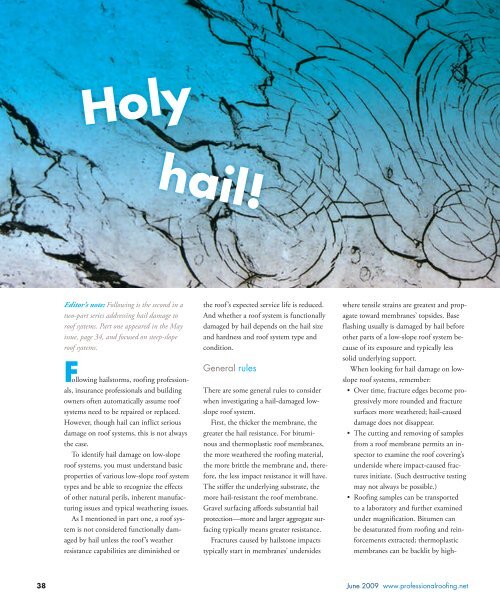

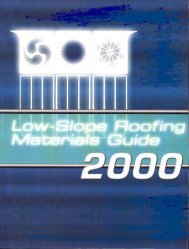
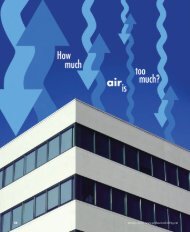

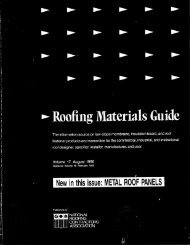
![Wm] - National Roofing Contractors Association](https://img.yumpu.com/36696816/1/190x245/wm-national-roofing-contractors-association.jpg?quality=85)

